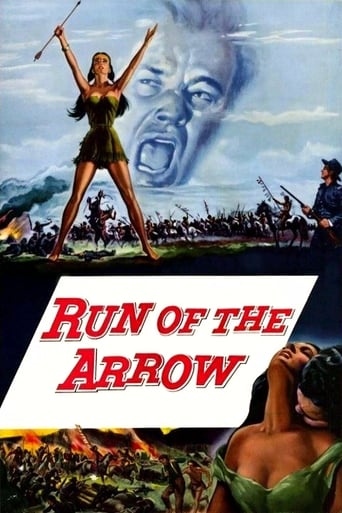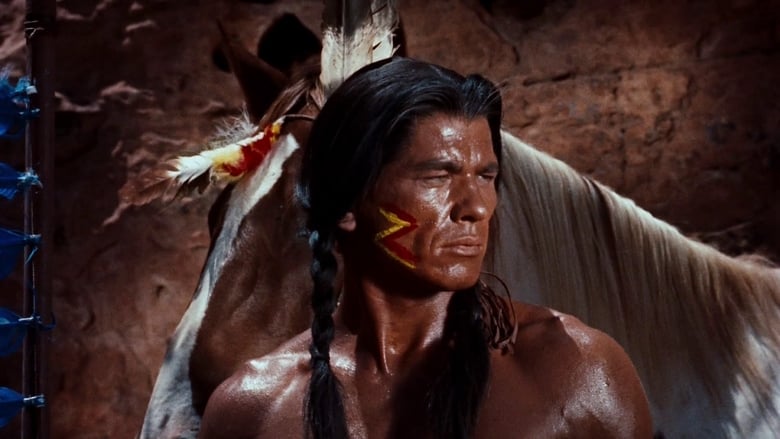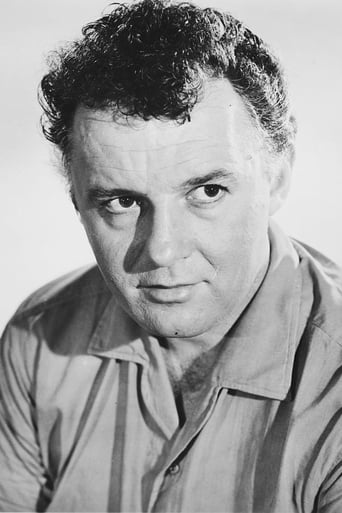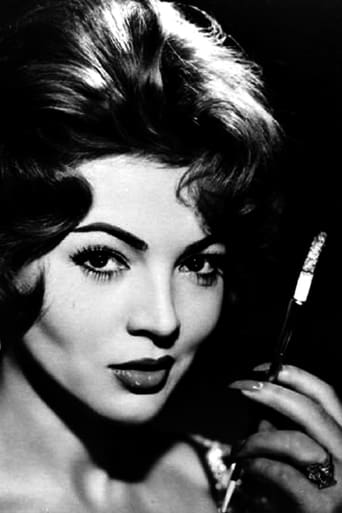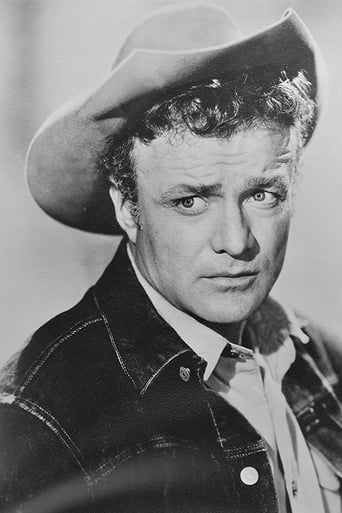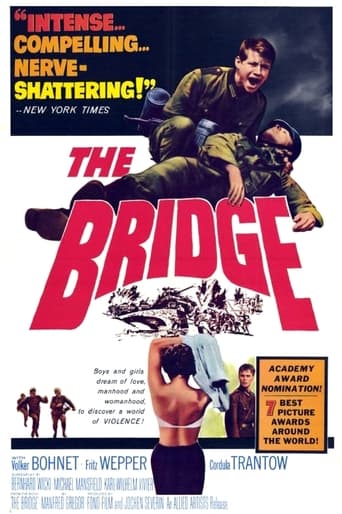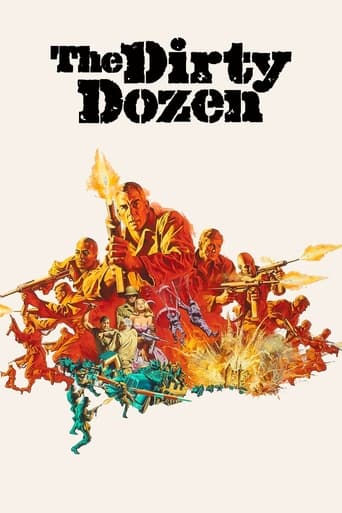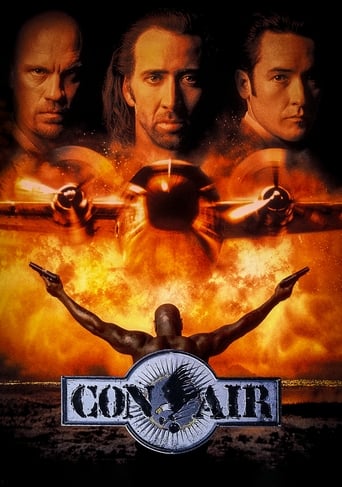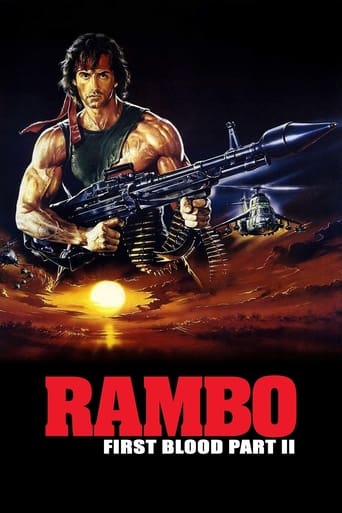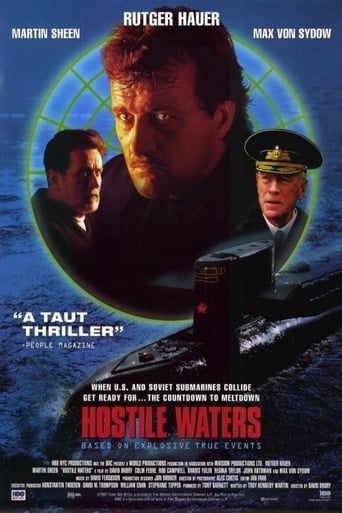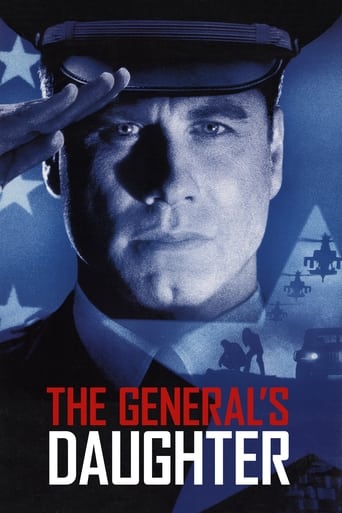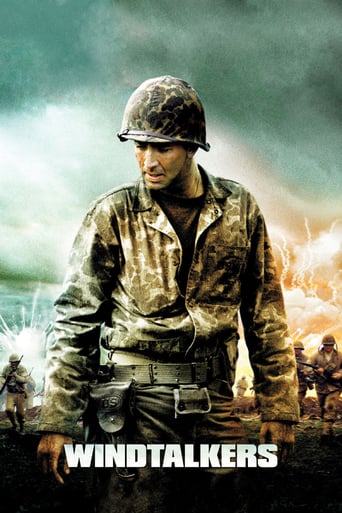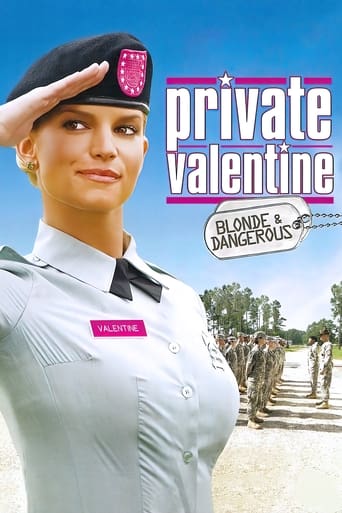Run of the Arrow (1957)
When the South loses the war, Confederate veteran O'Meara goes West, joins the Sioux, takes a wife and refuses to be an American but he must choose a side when the Sioux go to war against the U.S. Army.
Watch Trailer
Free Trial Channels
Cast


Similar titles
Reviews
I really wanted to like this movie. I feel terribly cynical trashing it, and that's why I'm giving it a middling 5. Actually, I'm giving it a 5 because there were some superb performances.
It's easily one of the freshest, sharpest and most enjoyable films of this year.
The acting in this movie is really good.
Blistering performances.
Run of the Arrow is written and directed by Sam Fuller. It stars Rod Steiger, Sara Montiel, Brian Keith, Ralph Meeker, Jay C. Flippen and Charles Bronson. Music is scored by Victor Young and Technicolor cinematography is by Joseph Biroc.As the American Civil War closes, Confederate Pvt. O'Meara (Steiger) finds he just can't bring himself to be part of the United States. With his head full of memories about what the Yankees put his kind through, and a heart full of bile, he decides to go West and live native. Here he encounters the Sioux and his life takes on a new meaning.....Run of the Arrow, and director Sam Fuller in general, has grown a sterling reputation over the decades. Where Fuller's rep as the American Primitive auteur is well deserved, Run of the Arrow's is not. It seems that the themes at work, and they are strong and potent, have made many forget the glaring flaws in the production.Churning away in the screenplay are themes of nationalism, identity, loyalty and racism, with the dialogue well scripted, but these themes are hardly presented as complex issues. Literally overnight O'Meara has a grasp on Sioux customs and language, with the Sioux not afforded any characterisation outside of O'Meara's musings (the authoritative voice after one day of going native!) and a brief scene where Blue Buffalo (Bronson) bizarrely accepts the Christian faith is the same as the Sioux faith. Ultimately the presentation of the Sioux is so one dimensional it's nigh on impossible to accept that O'Meara is now conflicted in his calling.Then there is the small matter of Steiger's miscasting. As some critics have fallen over themselves to laud the film as an ambitious masterpiece, they have forgotten about the lead man's misplacement. The attempt at an Irish accent is woeful, it comes off as more like an Eastern Europe and Asian mix, thankfully he gives up later in the film to give our ears a rest. But he is also physically wrong as well, we are asked to believe that his stocky frame can outrun lithe and muscular Sioux warriors, it's insulting even when taking artistic licence into account. Amusingly some critics of the time praised Fuller for fluidly tracking running feet as opposed to full bodied character, truth is it wasn't artistic intent, Steiger had sprained his ankle so Fuller had to shoot another actor running! It's just one of the many irrelevant scenes in the picture.The use of white actors to play Indians always causes friction with Western fans, sometimes it works and sometimes it doesn't. Here it cuts both ways, Bronson gets away with it, he looks the part, but Flippen is embarrassingly unconvincing as Walking Coyote and Montiel as Yellow Moccasin is done up like a porn version of a Sioux squaw! (voice dubbed by Angie Dickinson as well). It's hard to focus on strong thematics when Steiger is talking through a mouth full of beans, Flippen looks like he has wandered in off of an L.A. street and Montiel is making you horny with a shapely thigh! Where the film lifts itself above average is with Fuller's knack for stylised violence and the location photography of Biroc (latterly Ulzana's Raid). Officially the first film to use squibs for bloody impact of weapons, Fuller utilises this to the max, there's also some excellent flaming arrow work as well. Even though the print I viewed of the film is drab and scratchy, you can still see the great work of Biroc as he brings the beauty of St George, Utah, to Fuller's harsher human edges. While Young's score is inventive in blending Civil War and Irish tunes into the otherwise standard Cavalry and Indians mix.I consider myself a big Fuller fan, I love Forty Guns, Shock Corridor and The Naked Kiss, but Run of the Arrow has too much wrong with it to deserve the "great" reputation it has. While those trying to put it forward as being this great inspiration that Dances With Wolves copied! Are seriously barking up the wrong tree. Each has a disenchanted soldier venturing West and encountering the Sioux, from there on in, though, the films vastly differ. 6/10
Run of the Arrow (Samuel Fuller, 1957) is an embryonic version of Dances With Wolves in director Sam Fuller's familiar tabloid style: short, flamboyantly written and with the best stuff right at the top. It begins on Palm Sunday, 1865, "the last day of the war between the states", with Fuller taking us to the very heart of the conflict via a mesmerising opening tracking shot. Corpses are strewn across the smoking landscape, where an unmanned cannon has fallen silent, smashed to pieces. An air of desperation and exhaustion hangs heavy over the action. A Yankee soldier on a knackered horse staggers towards some unknown, meaningless destination. A shot rings out and he slumps to the ground. A Confederate infantryman (Rod Steiger) lowers his gun and moves forward. Ransacking the man's pockets, he finds a food parcel and begins eating the spoils off the dying man's stomach. That line from The Night They Drove Old Dixie Down comes to mind: "We were hungry, just barely alive." Having had his fill, Steiger straps the man to the guy's own horse, and takes him to a field hospital. It's a brilliant intro. But then Steiger starts talking and the film goes downhill.Accents are a funny thing. It's nice when someone gets a voice down pat, but it often feels like window-dressing. And illogical window-dressing at that, since Nazis don't generally converse with one another in heavily-accented English. Jimmy Stewart gave a great performance in The Shop Around the Corner without attempting a Hungarian accent, and Claude Rains was a fitting French captain in Casablanca despite his distinctive English tones. Keeping your own accent also means you avoid taking a road to supposed 'authenticity' that's full of pitfalls. A terrible voice can sink a film, or at least prove a major distraction, and that's the case here. Playing a second-generation Irish immigrant fighting for the Confederacy, who finds a new home with the Sioux, Steiger opts for an accent that can best be described as 'South Asian Norwegian'. Perhaps he was confused about playing an honorary Indian, because no matter how bold and progressive the film is, offering an insightful look at Sioux customs, it still has a hero who sounds like a sort of Slumdog John Qualen. By d'yevil.Such self-satisfied broadsides aside (I'm sorry, I really do like Fuller), Run of the Arrow turns out alright. The titular rite-of-passage - which sees Steiger forced to outpace some rampaging Sioux, or else find a new skin - is exciting and well-paced, with an intelligent follow-up in the second half. Fuller's much-celebrated focus on the feet during that sequence was actually enforced by Steiger's sore ankle, but elsewhere there's some strong direction that makes the most of several ambitious, realistic sets. Steiger is periodically effective, even hampered by that ridiculous voice, with Ralph Meeker perfectly cast as his main nemesis - a cigar-chomping Indian-hater - and Brian Keith an effective moral yardstick, though the rest of the cast is largely nondescript. The interesting, well-researched portrait of the Native American lifestyle is ultimately overtaken by a drawn-out action climax that begins effectively, with an interesting subversion of Western folklore that sees the Indians riding to the rescue, but frankly goes on a bit. Fuller's script also lacks clarity, even when dealing with his favourite theme of redemption, which is very unusual for this filmmaker.In the end, Run of the Arrow is a fascinating, admirably ambitious film, but it's a long way from being a classic, with confused plotting and an inability to build on its fascinating opening scenes. On this evidence, it's a damn shame that Fuller never made a full Civil War picture, as he seems ideally suited to the material. But then again, every Fuller film starts and ends with a bang, and though John Ford's 21-minute section of How the West Was Won ('The Civil War') is extraordinary, his feature-length treatment of the conflict he remained so obsessed with, The Horse Soldiers, is a shambles.Trivia note: This was the first movie to use blood squibs. No Run of the Arrow, no Wild Bunch. A small price to pay for that peculiar thing Steiger is doing with his larynx.
Watched this the other day and it was an interesting Cavalry vs. Indian (Sioux) film taking place before the establishment of Ft. Abraham Lincoln, and Custer. Steiger (who personally I think sucks at accents) plays a Confederate soldier with a weird Irish/Southern accent who fires the last shot in the Civil War, at Ralf Meeker, who he wounds.He basically refuses to surrender after Appomattox and heads off to the Northern Great Plains along the way he befriends an old Sioux cavalry scout, and he undergoes the ritual "run of the arrow" and becomes accepted by the tribe, where he continues the fight against the US.During the negotiations with the Sioux over establishing posts to separate settlers (keeping them off the hunting grounds) traveling West and the natives their chief, played by Charles Bronson, and the chief cavalry engineer played by Brian Keith they agree to select Steiger as chief Sioux scout for the expedition, not all of the Sioux are in concert with this. Keith and Steiger sort of hit it off but Meeker is a hot headed second in command who after Keith is hit by a renegade arrow decides to locate the new post in a different location than agreed, to igniting a war.Its an interesting take on the subject and the film is worth a watch but its nothing outstanding.
Rod Steiger's accent is so bad I didn't realise until some way into this picture that he was supposed to be Irish.German?Polish...Lithuanian?He certainly had me guessing I can tell you.Fortunately when he got to make "Henderson" 18 years later he got the Belfast accent down a lot better. Being a Reb does have a certain romance to it I suppose,fields full of waving cotton, ante - bellum houses just like "Tara",blinding white in the Southern sun,slaves singing in their quarters........sorry, my pity for the beaten Confederacy is strictly limited.And,of course,being an Irishman,he would be a natural reb anyway,so he would.Mr Steiger,when I finally sorted his accent out,is portraying a glorious double - cliché figure,a man without a country who,even if he had a home,wouldn't want to go back there. He marries the Indian woman who saves his life (the way you do),becomes accepted in the tribe and represents the Sioux nation in talks with the treacherous white eyes.After lots of adventures he decides he doesn't fit into either culture and wanders off with his family and some survivors of the U.S. Army unit his erstwhile people have pretty much slaughtered.That's "Run of the arrow" for you.Jay C.Flippen,one of the best known Western character actors plays an Indian scout with a ludicrous syrup.Where's the respect for Native American culture there? He looks as embarrassed as I felt watching him.The voice of Steiger's wife is dubbed by Angie Dickinson.Charles Bronson - under gleaming gold make up - plays a Polish Indian chief . Samuel Fuller,beloved of the auteurists,was a good pro who did what he had to do and,if he could,did at least a bit of it his way. Unfortunately for "Run of the Arrow",not much of it was done his way.

